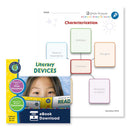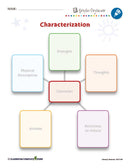Description
**THIS IS AN INSTANT DOWNLOAD**
This FREE worksheet includes 1 page from our Literary Devices title.
The Characterization Graphic Organizer provides a very complete description of character traits. This Graphic Organizer is a series of six rectangles arranged like the spokes in a wheel. The rectangle in the middle is the place you will write the name of your character. In each rectangle that radiates from the center, one of these titles and questions are written: 1. Dialogue (What does the dialogue reveal about him or her?); 2. Physical Description (What does he or she look like?); 3. Thoughts (What is he or she thinking?); 4. Actions (What do actions reveal about him or her? include gestures, motions); and 5. Reactions of Others (What do others think of him or her?). This worksheet can be used on its own, or paired with the individual resource. And the best part is, it's FREE.
************************************************************************
About the full resource, Literary Devices:
Explore the language of storytelling and discover the meaning and purpose of literature with Literary Devices. Definitions of important terms and many opportunities to practice the skills being taught make our resource user-friendly and easy to understand. Examine the fundamental devices that make up any story, starting with characterization. Break down a character into their simple parts: dialog, appearance, thoughts, actions, and reactions. Take a look at the time, place and conditions of a story. Learn how setting can help establish the mood or atmosphere. Use graphic organizers to map out the plot. Find out how a story unfolds with the rising action, climax and resolution. Next, dissect a story's main purpose by identifying its theme and point of view. Aligned to your State Standards and written to Bloom's Taxonomy, reproducible writing tasks, crossword, word search, comprehension quiz and answer key are also included.
This FREE worksheet includes 1 page from our Literary Devices title.
The Characterization Graphic Organizer provides a very complete description of character traits. This Graphic Organizer is a series of six rectangles arranged like the spokes in a wheel. The rectangle in the middle is the place you will write the name of your character. In each rectangle that radiates from the center, one of these titles and questions are written: 1. Dialogue (What does the dialogue reveal about him or her?); 2. Physical Description (What does he or she look like?); 3. Thoughts (What is he or she thinking?); 4. Actions (What do actions reveal about him or her? include gestures, motions); and 5. Reactions of Others (What do others think of him or her?). This worksheet can be used on its own, or paired with the individual resource. And the best part is, it's FREE.
************************************************************************
About the full resource, Literary Devices:
Explore the language of storytelling and discover the meaning and purpose of literature with Literary Devices. Definitions of important terms and many opportunities to practice the skills being taught make our resource user-friendly and easy to understand. Examine the fundamental devices that make up any story, starting with characterization. Break down a character into their simple parts: dialog, appearance, thoughts, actions, and reactions. Take a look at the time, place and conditions of a story. Learn how setting can help establish the mood or atmosphere. Use graphic organizers to map out the plot. Find out how a story unfolds with the rising action, climax and resolution. Next, dissect a story's main purpose by identifying its theme and point of view. Aligned to your State Standards and written to Bloom's Taxonomy, reproducible writing tasks, crossword, word search, comprehension quiz and answer key are also included.






